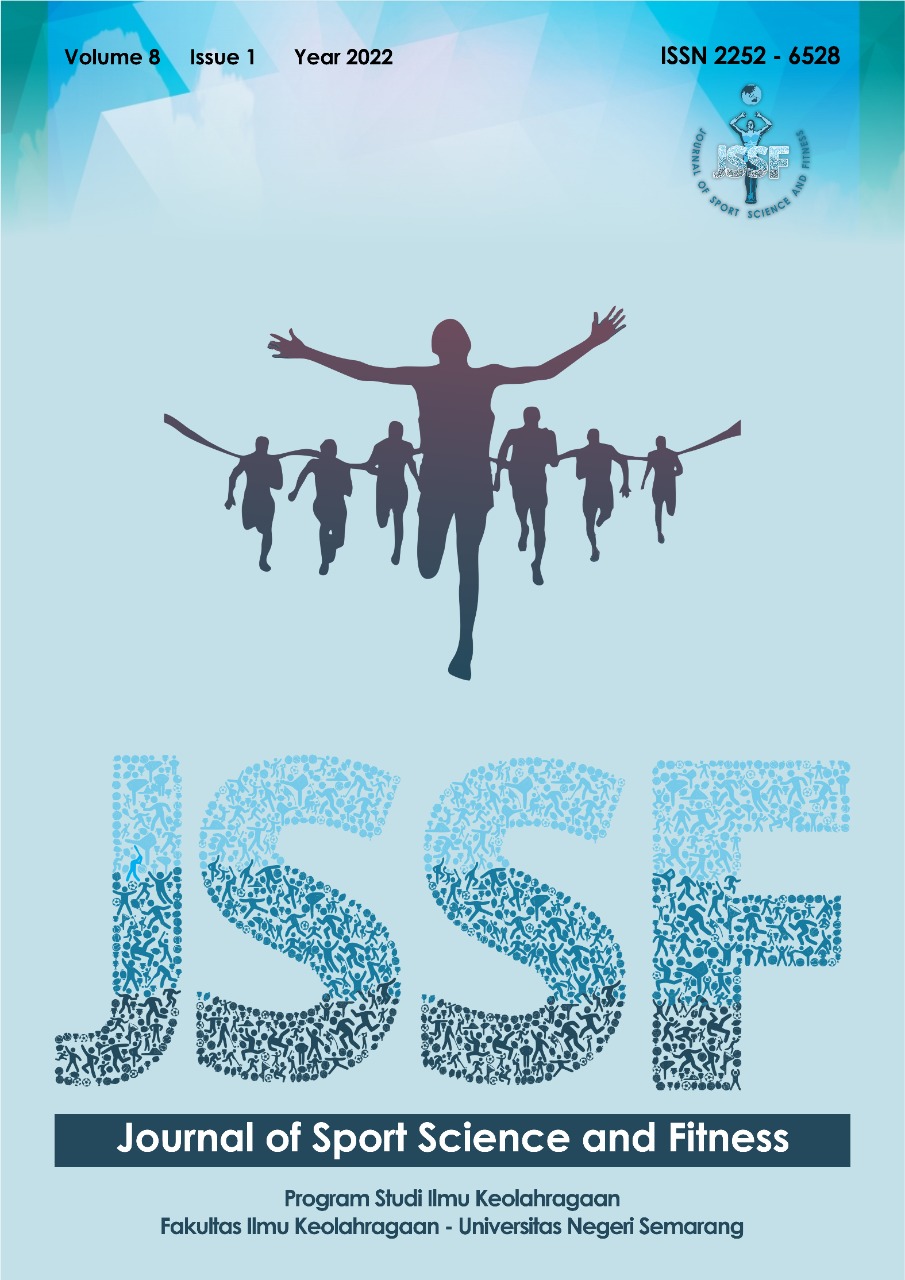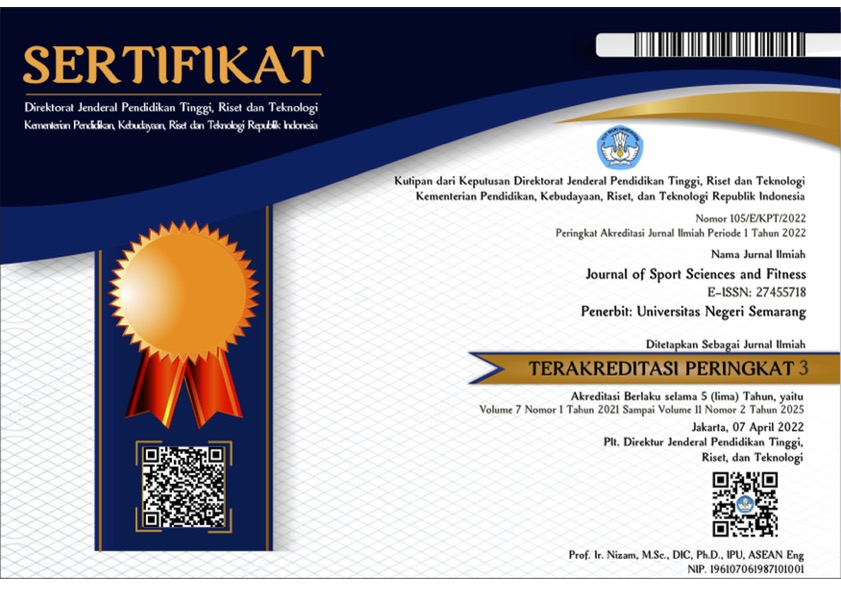ROBOPAS (ROBOT KIPAS) PENGEMBANGAN MEDIA LATIHAN MULTIBALL TENIS MEJA
Abstract
Abstrak
Penelitian ini dilatarbelakangi karena mahalnya alat Latihan multiball. Tujuan penelitian ini adalah mengembangkan media multiball dengan bahan dan biaya yang lebih terjangkau. Jenis penelitian ini adalah penelitian pengembangan atau Research and Development (R&D). Teknik pengambilan sampel menggunakan purposive sampling dengan jumlah 10 atlet saat uji coba skala kecil dan 20 atlet saat uji skala besar (uji lapangan). Dalam pelaksanaannya dilakukan lah tahapan tahapan dalam penelitiannya antara lain: potensi permasalahan, dikumpulkannya data, mendesain produk, memvalidasi desainnya, merevisi model, penguujian produk, perevisian produk, penguji cobaan pemakaiannya. Validasi dilakukan kepada ahli materi, ahli media, dan atlet HW SPORT. Teknik pengumpulan data menggunakan angket. Terdiri dari angket untuk ahli media sebagai bahan analisis alat dan angket untuk atlet sebagai respon terhadap kelayakan alat. Teknik analisis data menggunakan data deskriptif kualitatif dan deskriptif kuantitatif persentase. Hasil menunjukan media robopas yang “sangat layak” dipakai dalam menjadi media dalam pembelajaran maupun latihan olah fisik. Perolehan itu didapatkan dari validasi akhirnya dari a) ahli materi 90% atau layak; b) ahli media 83% atau layak; c) atlet pengujicobaan dilapangan sejumlah 88,8% atau layak. Kesimpulan penelitian ini adalah alat robopas sebagai media berlatih multiball layak digunakan. Alat ini dapat dimanfaatkan guna sarana bantu dalam pelatihan cabang olahraga permainan untuk menunjang prestasi.
Abstract
This research is motivated by the high cost of multiball training equipment. The purpose of this research is to develop multiball media with more affordable materials and costs. This type of research is research and development (R&D). The sampling technique used purposive sampling with a total of 10 athletes during a small-scale trial and 20 athletes during a large-scale test (field test). In its implementation, the stages of research are carried out, including: potential problems, collecting data, designing products, validating designs, revising models, testing products, revising products, testing trials of their use. Validation was carried out to material experts, media experts, and HW SPORT athletes. Data collection techniques using a questionnaire. Consists of a questionnaire for media experts as a tool for analysis and a questionnaire for responses to suitable tools. The data analysis technique used descriptive qualitative data and descriptive quantitative percentages. The results show that robopas media is "very feasible" to be used in learning media and physical exercise. The gain is obtained from the final validation from a) material expert 90% or worthy; b) 83% media expert or appropriate; c) test athletes in the field number 88.8% or eligible. The conclusion of this study is that the robopas tool as a multiball practice medium is feasible to use. This tool can take advantage of auxiliary facilities in the training of sports games to support achievement.
References
Blackwell, W. (2015). ABC of Sports and Exercise Medicine (G. P. Whyte, M. Loosemore, & C. Williams (eds.); Fourth Edi).
Borrie, A. (2016). Coaching Science. Science and Soccer, 243–258. https://doi.org/10.4324/9780203131862
Grimshaw, A & Burden, A. (2007). Sports & Exercise Biomechanics. In Bios Instant Notes (1st ed., Vol. 1, Issue 2). Taylor & Francis Group.
Husdarta. (2010). Sejarah dan filsafat olahraga. In Bandung : Alfabeta.
Kress, T. M. (2011). Critical Praxis Research (Issue 1). https://doi.org/10.16309/j.cnki.issn.1007-1776.2003.03.004
McNamee, M. (2004). Philosophy and the Sciences of Exercise, Health and Sport. In Philosophy and the Sciences of Exercise, Health and Sport. https://doi.org/10.4324/9780203506004
Permatasari, D. (2017). Buku Pintar Tenis Meja (1st ed.). Jakarta : Anugrah.
Pratama, I. D., Herlambang, T., Kusumawardhana, B., & Royana, I. F. (2020). Go Pong: Media Pembelajaran Teknik Dasar Tenis Meja Berbasis Android. Jendela Olahraga, 05(1), 86–90.
Wibisana, M. I. N. (2018). Pengaruh Pemberian Xanthone Kulit Manggis Terhadap Kadar Asam Laktat Pada Aktivitas Fisik Submasimal. Jendela Olahraga, 3(1), 22–30. https://doi.org/10.26877/jo.v3i1.2029
Wibisana, M. I. N. (2020). Analisis Indeks Kelelahan dan Daya Tahan Anaerobic Atlet Futsal SMA Institut Indonesia Semarang. Jurnal Terapan Ilmu Keolahragaan, 5(2), 140–144. https://doi.org/10.17509/jtikor.v5i2.26956
Williams, C. (2014). Data Analysis and Research for Sport and Exercise Science. Data Analysis and Research for Sport and Exercise Science. https://doi.org/10.4324/9780203642245
Wirasasmita, R. (2020). Permainan Tenis Meja di Indonesia (1st ed.). Bandung : Alfabeta.
Yang, L., Zhang, H., Zhu, X., & Sheng, X. (2021). Ball Motion Control in the Table Tennis Robot System Using Time-Series Deep Reinforcement Learning. IEEE Access, 9, 99816–99827. https://doi.org/10.1109/ACCESS.2021.3093340








